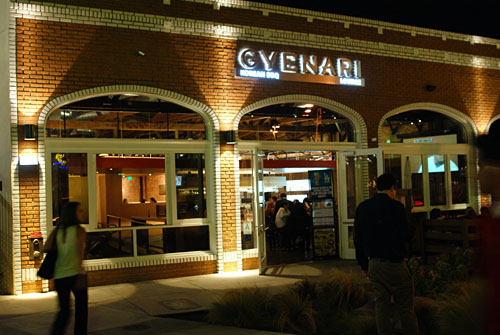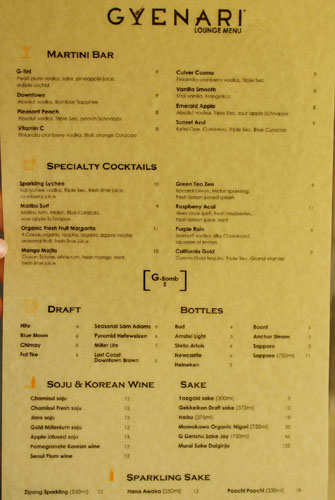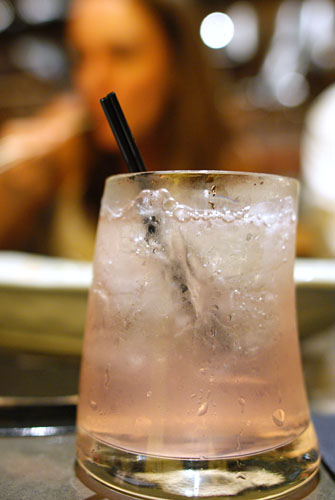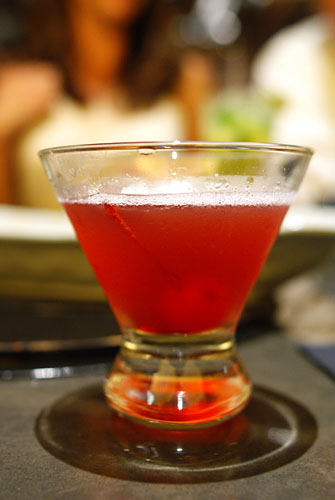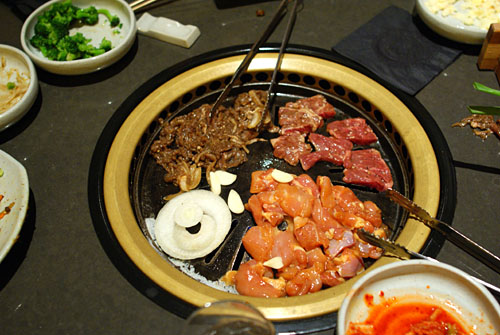Musha (Santa Monica, CA)
Musha
424 Wilshire Blvd, Santa Monica, CA 90401
310.576.6330
www.musha.us
Sat 10/31/2009, 06:00p-07:15p
What do food bloggers do for Halloween? Go out to eat, of course! For All Hallow's Eve this year, Christine of Folie à Choisauce organized a small get-together at Musha, an izakaya in Santa Monica helmed by general manager/chef extraordinaire Taku Suzuki (there's also a sister location in Torrance). For the uninitiated, izakayas are basically Japanese-style pubs, featuring small, savory plates of food meant to be paired with beer and/or sake. The atmosphere inside an izakaya is usually fun, festive, flirty, lubricated by the omnipresent flow of booze--the ideal vibe for a Halloween dinner. And if you're wondering about the name, in Japanese, musha musha is the sound effect for eating, basically the onomatopoeic counterpart of the English echoism nom nom (which was itself first popularized by Cookie Monster, and subsequently by LOLcats).
Also in attendance for the dinner portion of the evening were Danny of Kung Food Panda, Nathan of Binary Tastebuds, Sonja of The Active Foodie, as well as Christine's oppa, John.

Musha is located in the heart of Santa Monica, sandwiched between Wahoo's Fish Tacos and a Chevron gas station. Parking can be tricky on the street, so I'd recommend one of the many public parking structures in the area, which command a flat rate of $3 after 6:00. The nearest one is on the southwest corner of 4th and Wilshire.

We were pretty much the first party to arrive, so the place was nearly empty to begin with, but would later teem with throngs of revelers and roisterers (the rotund-ish man in the doorway, dressed in a UPS uniform, is none other than Taku-san). Being early did allow us, however, to commandeer the private tatami room in the back, which accommodates up to 10 people (minimum charge of $200).
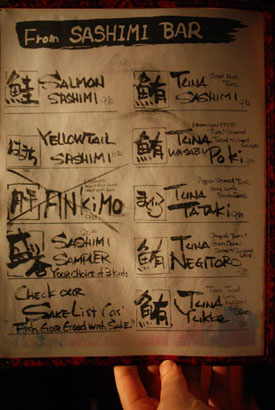





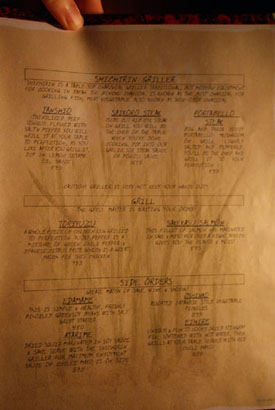

Musha's menu, full of colorful descriptions and endearing grammatical errors (such as the seemingly nonsensical "Chiller Santa Monica! Yes, we need this!!"), is a joy just to read; click for larger versions. In Japan, sushi and sashimi aren't considered popular izakaya fare, and though the versions in Los Angeles tend to offer raw fish items, I'd stick with the grilled, fried, and otherwise cooked courses.



Since izakayas are, at their heart, drinking establishments, the drink menu must be considered as well. A selection of beer, wine, shochu, and sake is on offer, but no liquor; click for larger versions. We ordered up two pitchers of Sapporo Draft [$12], as well as three decanters of sake: first the Yoshi No Gawa [$18] from Niigata, then the Hananomai [$18] from Shizuoka, and finally the premium Hakkaisan [$28] from Niigata.

Spicy Tuna Dip [$8.95]
We started with one of Musha's most famous dishes. Everybody's had a spicy tuna roll at some point, but here it's served as a dip, paired with crispy rice crackers. As expected, it was a quite tasty, a gorgeous amalgam of rich tuna and spicy sauce, heightened by a fantastic crunch from the rice, with a bit of lingering heat. Nice.



Aburi Saba [$11.00]
Christine insisted that we just had to order this, so we did: a dish of vinegar-marinated mackerel filet, sliced and torched tableside, garnished with gari, wasabi, and karashi. The searing really brought out the oiliness of the saba, but fortunately, its fishiness was relatively tame. It was pretty good by itself, but positively superb when paired with the acerbic, biting tang of the ginger. Note: our server was a guy, in drag (remember, it was Halloween); some of us, though, did have to do a double take!

Lobster Roll [$7.95]
As regular readers will know, I usually eschew rolls, but somehow agreed to this. It was lobster, avocado, cucumber, masago roe, and mayo, rolled up in seaweed and soy paper, sans rice. It certainly wasn't offensive, but the essence of lobster was really lost here, and the flavors in general seemed muddled, indistinct.

Tofu French Fries [$5.95]
How do you get uptight Americans to eat tofu? Cut it up into parallelepiped form, deep fry the suckers, and call 'em French fries. Seriously though, this wasn't bad at all. The "fries" were pretty mild flavor-wise, so really the sauce was the key here. Creamy wasabi and sweet chili condiments were provided; the latter was a bit too sweet for my tastes, but the tofu was superb with the former.

Negitoro Tuna Croquette [$6.95]
Next was negi (green onion) and toro (tuna), minced into a slurry along with garlic, pepper, and hijiki seaweed, breaded, and tossed into the deep fryer. Though my croquette was perhaps a touch dry, I rather enjoyed it, a nice admixture of savory tuna, tarted up by the tang of scallion. Even better with the paired grated daikon-mayo dip.

M.F.C [$7.95]
No, M.F.C doesn't stand for Most Fobbiest Chicken; rather, it's Musha Fried Chicken, or soy sauce/sake/ginger/garlic-marinated chicken filet, breaded with cornstarch, deep fried, and served with two kinds of grated daikon, as well as ponzu. It certainly was tasty enough, albeit a bit blunt, and could've been a touch tenderer. Good, but not at the level of a truly sublime fried chicken (for sublime, refer to Ludo's duck fat fried chicken, the buttermilk fried chicken at Ad Hoc, or Ira's Javanese-style ayam goreng).

Takotama [$6.95]
The menu advertised this as Musha's signature dish, so it was a must try for us. It was basically a two-layer noodle omelet, with octopus (tako), leeks, red ginger, and bonito broth (katsuobushi dashi), smothered in a dark, viscous sauce--think of it as an unholy marriage between takoyaki and okonomiyaki. There was a real multitude of tastes, with the octopus itself acting as more of a textural component. The initial flavor sensation was vaguely reminiscent of Indian-style curry, with the umami-rich flavor of the bonito coming in later.

Tanshio [$8.95]
And now, for a little yakiniku action. Here we have thinly-sliced beef tongue (tan), topped with salt (shio) and pepper, and grilled. Now normally, the grilling is performed by the diners, but given that the tatami room can't accommodate the shichirin charcoal grills normally used, the kitchen had to grill the meat for us. I'm not complaining, as the tongue turned out quite delicious--unctuous, super saporous, imbued with an immensely beefy flavor. Even better when dipped in the provided lemon-sesame oil sauce.


Musha's Risotto [$8.80]
This was another dish that Christine insisted upon, but unfortunately, it didn't turn out quite as well as the Aburi Saba. It was basically a Japanese interpretation of classic Italian risotto: brown rice cooked with chicken broth, then pan-fried with Prosciutto, onion, and soy milk. The whole concoction was then mixed tableside in a block of cheese by our lovely "waitress." Great concept, but the execution left me wanting. There was a distinct lack of flavor, like the kitchen forgot to add any salt or seasoning!

Butakim [$7.80]
Next was one of my favorite items of the night: thinly-sliced pork, stir-fried with napa cabbage (baechu) kimchi and mushrooms, doused with soy sauce. The key was the kimchi, which was a superb temper to the savory pork. Great with beer.

Char-Han [$6.95]
Our last savory course was a spicy fried rice with ground pork, Thai chili, bamboo shoot, ginger, garlic, leek, and egg, finished with fish sauce, cilantro, and red ginger. It wasn't very spicy sadly, and the flavor in general was rather muted--I didn't get much of the pork, fish sauce, bamboo, or ginger really. The cilantro was a great touch, though.
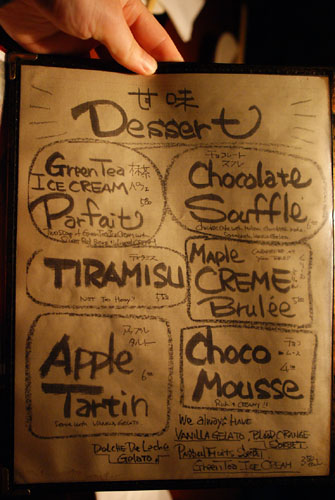
Interestingly, izakayas in Japan often do not offer dessert. However, Taku-san is a fan of the sweet stuff, so he does push them at Musha. Click for a larger version.

Before dessert was served, we were given cups of tea, filled with what I believe was umeboshi, or pickled ume fruit.


Maple Crème Brûlée [$5.80]
Continuing on with the he-she blowtorch action, we started off with a crème brûlée, caramelized tableside. It was about what you'd expect, with a somewhat heavier, richer flavor from the use of maple syrup flavoring.

Chocolate Soufflé [$6.00]
Next was the chocolate soufflé cake, basically a chocolate cake with a liquid chocolate interior, served with vanilla gelato. It was certainly tasty enough, the gelato proving a nice counter to the decadence of the chocolate, but variations of the molten chocolate cake are almost clichéd at this point I think.


Apple Tartin [$6.00]
Finally, we have Musha's take on the classic apple tarte tatin, torched tableside, served with the same vanilla gelato as above, along with a sprig of rosemary. It was a fairly standard presentation except for the rosemary, which provided an astringent, herbal counterbalance to the dish.

Conclusively, complementary cuts of cantaloupe to close.

And finally, the requisite group photo, minus Nathan (who left to attend a Cirque du Soleil show with Connie of Hey Hey Scenesters), with our lovely server; note "her" use of double fob "V" signs.


The night was still young, so we made our way down Santa Monica's Third Street Promenade, looking for a nearby bar to wet our whistles...

...Finally settling upon Copa d'Oro, where we were joined by Twitterer and famed cupcake-maker Remil, as well as Dave. We took a seat at the bar...

...And ordered up a round of the Halloween night special, the Sagatiba Cursed Caipirinha [$10], a delightful cocktail combining the sweetness of blood orange with the alcoholic bite of cachaça. As we were finishing up our drinks, we moved from the bar to a table...

...Where we were tempted by the shot girl, who was pushing shots of the aforementioned Sagatiba cachaça [$5], to be chased by small slices of blood orange dipped in a sugar/cinnamon mixture. We succumbed to her charms and accent and ordered a round. The cachaça itself was surprisingly smooth, given its potency, and the chaser was perfect, leaving a lingering sweet spiciness in our mouths. More booze was necessary...

...So Christine decided to ask owner/bartender Vincenzo Marianella for a custom cocktail, utilizing ginger as well as her favorite liquor, gin. The resultant concoction, shown above with the John's Rhode Island Red (sorry for the subpar photo), was absolutely profound in its gingeriness--in the words of the eternally sage Ralph Wiggum: it tastes like burning. Once we polished off the drinks...


...We made our way outside, to decide where we were going next. But there wasn't much deliberating to be done; there was only one option really: noraebang (Korean-style karaoke). Thus, we wandered back to our cars, and made the trek over to K-Town, stopping at Palmtree LA, supposedly the poshest karaoke joint around (Nathan would join us later on). There won't be any more photos from here on (wisely left my camera in the car), though apparently, there might be a video floating around of me doing a pretty mean rendition of Taylor Swift's Love Story...
424 Wilshire Blvd, Santa Monica, CA 90401
310.576.6330
www.musha.us
Sat 10/31/2009, 06:00p-07:15p
What do food bloggers do for Halloween? Go out to eat, of course! For All Hallow's Eve this year, Christine of Folie à Choisauce organized a small get-together at Musha, an izakaya in Santa Monica helmed by general manager/chef extraordinaire Taku Suzuki (there's also a sister location in Torrance). For the uninitiated, izakayas are basically Japanese-style pubs, featuring small, savory plates of food meant to be paired with beer and/or sake. The atmosphere inside an izakaya is usually fun, festive, flirty, lubricated by the omnipresent flow of booze--the ideal vibe for a Halloween dinner. And if you're wondering about the name, in Japanese, musha musha is the sound effect for eating, basically the onomatopoeic counterpart of the English echoism nom nom (which was itself first popularized by Cookie Monster, and subsequently by LOLcats).
Also in attendance for the dinner portion of the evening were Danny of Kung Food Panda, Nathan of Binary Tastebuds, Sonja of The Active Foodie, as well as Christine's oppa, John.

Musha is located in the heart of Santa Monica, sandwiched between Wahoo's Fish Tacos and a Chevron gas station. Parking can be tricky on the street, so I'd recommend one of the many public parking structures in the area, which command a flat rate of $3 after 6:00. The nearest one is on the southwest corner of 4th and Wilshire.

We were pretty much the first party to arrive, so the place was nearly empty to begin with, but would later teem with throngs of revelers and roisterers (the rotund-ish man in the doorway, dressed in a UPS uniform, is none other than Taku-san). Being early did allow us, however, to commandeer the private tatami room in the back, which accommodates up to 10 people (minimum charge of $200).








Musha's menu, full of colorful descriptions and endearing grammatical errors (such as the seemingly nonsensical "Chiller Santa Monica! Yes, we need this!!"), is a joy just to read; click for larger versions. In Japan, sushi and sashimi aren't considered popular izakaya fare, and though the versions in Los Angeles tend to offer raw fish items, I'd stick with the grilled, fried, and otherwise cooked courses.



Since izakayas are, at their heart, drinking establishments, the drink menu must be considered as well. A selection of beer, wine, shochu, and sake is on offer, but no liquor; click for larger versions. We ordered up two pitchers of Sapporo Draft [$12], as well as three decanters of sake: first the Yoshi No Gawa [$18] from Niigata, then the Hananomai [$18] from Shizuoka, and finally the premium Hakkaisan [$28] from Niigata.

Spicy Tuna Dip [$8.95]
We started with one of Musha's most famous dishes. Everybody's had a spicy tuna roll at some point, but here it's served as a dip, paired with crispy rice crackers. As expected, it was a quite tasty, a gorgeous amalgam of rich tuna and spicy sauce, heightened by a fantastic crunch from the rice, with a bit of lingering heat. Nice.



Aburi Saba [$11.00]
Christine insisted that we just had to order this, so we did: a dish of vinegar-marinated mackerel filet, sliced and torched tableside, garnished with gari, wasabi, and karashi. The searing really brought out the oiliness of the saba, but fortunately, its fishiness was relatively tame. It was pretty good by itself, but positively superb when paired with the acerbic, biting tang of the ginger. Note: our server was a guy, in drag (remember, it was Halloween); some of us, though, did have to do a double take!

Lobster Roll [$7.95]
As regular readers will know, I usually eschew rolls, but somehow agreed to this. It was lobster, avocado, cucumber, masago roe, and mayo, rolled up in seaweed and soy paper, sans rice. It certainly wasn't offensive, but the essence of lobster was really lost here, and the flavors in general seemed muddled, indistinct.

Tofu French Fries [$5.95]
How do you get uptight Americans to eat tofu? Cut it up into parallelepiped form, deep fry the suckers, and call 'em French fries. Seriously though, this wasn't bad at all. The "fries" were pretty mild flavor-wise, so really the sauce was the key here. Creamy wasabi and sweet chili condiments were provided; the latter was a bit too sweet for my tastes, but the tofu was superb with the former.

Negitoro Tuna Croquette [$6.95]
Next was negi (green onion) and toro (tuna), minced into a slurry along with garlic, pepper, and hijiki seaweed, breaded, and tossed into the deep fryer. Though my croquette was perhaps a touch dry, I rather enjoyed it, a nice admixture of savory tuna, tarted up by the tang of scallion. Even better with the paired grated daikon-mayo dip.

M.F.C [$7.95]
No, M.F.C doesn't stand for Most Fobbiest Chicken; rather, it's Musha Fried Chicken, or soy sauce/sake/ginger/garlic-marinated chicken filet, breaded with cornstarch, deep fried, and served with two kinds of grated daikon, as well as ponzu. It certainly was tasty enough, albeit a bit blunt, and could've been a touch tenderer. Good, but not at the level of a truly sublime fried chicken (for sublime, refer to Ludo's duck fat fried chicken, the buttermilk fried chicken at Ad Hoc, or Ira's Javanese-style ayam goreng).

Takotama [$6.95]
The menu advertised this as Musha's signature dish, so it was a must try for us. It was basically a two-layer noodle omelet, with octopus (tako), leeks, red ginger, and bonito broth (katsuobushi dashi), smothered in a dark, viscous sauce--think of it as an unholy marriage between takoyaki and okonomiyaki. There was a real multitude of tastes, with the octopus itself acting as more of a textural component. The initial flavor sensation was vaguely reminiscent of Indian-style curry, with the umami-rich flavor of the bonito coming in later.

Tanshio [$8.95]
And now, for a little yakiniku action. Here we have thinly-sliced beef tongue (tan), topped with salt (shio) and pepper, and grilled. Now normally, the grilling is performed by the diners, but given that the tatami room can't accommodate the shichirin charcoal grills normally used, the kitchen had to grill the meat for us. I'm not complaining, as the tongue turned out quite delicious--unctuous, super saporous, imbued with an immensely beefy flavor. Even better when dipped in the provided lemon-sesame oil sauce.


Musha's Risotto [$8.80]
This was another dish that Christine insisted upon, but unfortunately, it didn't turn out quite as well as the Aburi Saba. It was basically a Japanese interpretation of classic Italian risotto: brown rice cooked with chicken broth, then pan-fried with Prosciutto, onion, and soy milk. The whole concoction was then mixed tableside in a block of cheese by our lovely "waitress." Great concept, but the execution left me wanting. There was a distinct lack of flavor, like the kitchen forgot to add any salt or seasoning!

Butakim [$7.80]
Next was one of my favorite items of the night: thinly-sliced pork, stir-fried with napa cabbage (baechu) kimchi and mushrooms, doused with soy sauce. The key was the kimchi, which was a superb temper to the savory pork. Great with beer.

Char-Han [$6.95]
Our last savory course was a spicy fried rice with ground pork, Thai chili, bamboo shoot, ginger, garlic, leek, and egg, finished with fish sauce, cilantro, and red ginger. It wasn't very spicy sadly, and the flavor in general was rather muted--I didn't get much of the pork, fish sauce, bamboo, or ginger really. The cilantro was a great touch, though.

Interestingly, izakayas in Japan often do not offer dessert. However, Taku-san is a fan of the sweet stuff, so he does push them at Musha. Click for a larger version.

Before dessert was served, we were given cups of tea, filled with what I believe was umeboshi, or pickled ume fruit.


Maple Crème Brûlée [$5.80]
Continuing on with the he-she blowtorch action, we started off with a crème brûlée, caramelized tableside. It was about what you'd expect, with a somewhat heavier, richer flavor from the use of maple syrup flavoring.

Chocolate Soufflé [$6.00]
Next was the chocolate soufflé cake, basically a chocolate cake with a liquid chocolate interior, served with vanilla gelato. It was certainly tasty enough, the gelato proving a nice counter to the decadence of the chocolate, but variations of the molten chocolate cake are almost clichéd at this point I think.


Apple Tartin [$6.00]
Finally, we have Musha's take on the classic apple tarte tatin, torched tableside, served with the same vanilla gelato as above, along with a sprig of rosemary. It was a fairly standard presentation except for the rosemary, which provided an astringent, herbal counterbalance to the dish.

Conclusively, complementary cuts of cantaloupe to close.

And finally, the requisite group photo, minus Nathan (who left to attend a Cirque du Soleil show with Connie of Hey Hey Scenesters), with our lovely server; note "her" use of double fob "V" signs.


The night was still young, so we made our way down Santa Monica's Third Street Promenade, looking for a nearby bar to wet our whistles...

...Finally settling upon Copa d'Oro, where we were joined by Twitterer and famed cupcake-maker Remil, as well as Dave. We took a seat at the bar...

...And ordered up a round of the Halloween night special, the Sagatiba Cursed Caipirinha [$10], a delightful cocktail combining the sweetness of blood orange with the alcoholic bite of cachaça. As we were finishing up our drinks, we moved from the bar to a table...

...Where we were tempted by the shot girl, who was pushing shots of the aforementioned Sagatiba cachaça [$5], to be chased by small slices of blood orange dipped in a sugar/cinnamon mixture. We succumbed to her charms and accent and ordered a round. The cachaça itself was surprisingly smooth, given its potency, and the chaser was perfect, leaving a lingering sweet spiciness in our mouths. More booze was necessary...

...So Christine decided to ask owner/bartender Vincenzo Marianella for a custom cocktail, utilizing ginger as well as her favorite liquor, gin. The resultant concoction, shown above with the John's Rhode Island Red (sorry for the subpar photo), was absolutely profound in its gingeriness--in the words of the eternally sage Ralph Wiggum: it tastes like burning. Once we polished off the drinks...


...We made our way outside, to decide where we were going next. But there wasn't much deliberating to be done; there was only one option really: noraebang (Korean-style karaoke). Thus, we wandered back to our cars, and made the trek over to K-Town, stopping at Palmtree LA, supposedly the poshest karaoke joint around (Nathan would join us later on). There won't be any more photos from here on (wisely left my camera in the car), though apparently, there might be a video floating around of me doing a pretty mean rendition of Taylor Swift's Love Story...
